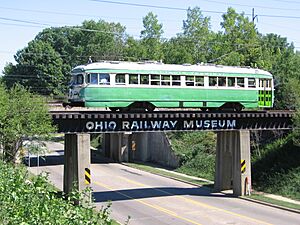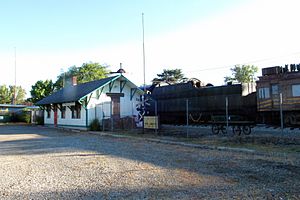Ohio Railway Museum facts for kids
The Ohio Railway Museum is a cool place where you can explore old trains and learn about railroad history! It's a railway museum that started way back in 1948. You can find it in Worthington, Ohio, which is close to Columbus.
Contents
- Discovering the Ohio Railway Museum's History
- What the Museum Does: Its Mission
- Amazing Trains and Cars: Collection Highlights
- Exploring the Collection: Detailed Descriptions
- Ohio Public Service #21: A Glimpse into Early Trains
- Norfolk & Western #578: A Powerful Steam Locomotive
- Marble Cliff Quarries #1: A Small but Mighty Engine
- Kansas City Public Service #472: An Early Streetcar
- Columbus Railway Power and Light #703: A Local Favorite
- Illinois Terminal Railroad #450: The Modern PCC Car
Discovering the Ohio Railway Museum's History
The Ohio Railway Museum is one of the oldest places in North America dedicated to saving and running old railroad equipment. It began in 1948 and officially became a non-profit group on August 22, 1950.
It started on the land of the old Columbus, Delaware and Marion Railway. Back then, it was called "The Central Ohio Railfans Association." Later, on February 17, 1993, its name officially changed to The Ohio Railway Museum.
What the Museum Does: Its Mission
The Ohio Railway Museum (ORM) is an educational group. Its main goal is to save and operate historic railway equipment. They especially focus on trains and artifacts from Ohio's railway past.
The museum teaches people through operating old trains. They also host special events and create publications. They are very involved in the community.
Amazing Trains and Cars: Collection Highlights
The museum has many interesting pieces of railway history. Here are some of the special ones you can see:
- Ohio Public Service #21
- Norfolk & Western #578
- Marble Cliff Quarry Co. #1
- Kansas City Public Service #472
- Columbus Street Railway (Columbus & Southern Electric) #703
- Illinois Terminal Railroad #450
- Columbus & Southern Ohio Electric #2
- Youngstown and Ohio River Railroad #7
- Cincinnati and Lake Erie Railroad #119
- Greater Cleveland Regional Transit Authority (RTA) #163
- Columbus, Delaware and Marion Railway #501
- Ohio Public Service #64 (Built As #41)
- United States Army Transportation Corps #7178
Exploring the Collection: Detailed Descriptions
Ohio Public Service #21: A Glimpse into Early Trains
Car #21 was the very first piece the museum got in 1947. It moved to the museum grounds in 1948. This car is a great example of how wooden interurban cars were built around 1900-1910.
It was made by the Niles Car and Manufacturing Company in Niles, Ohio, in 1905. It's a "combination passenger-baggage" type interurban car. This means it carried both people and their luggage.
The car is about 50 feet 6 inches (15.39 meters) long. It weighs about 60,500 pounds (27,442 kilograms). It has four General Electric motors, each with 65 horsepower. It also has a General Electric controller and a Westinghouse air compressor.
Car #21 and its sister car #20 had a baggage area at the front. There was also a smoking section that could seat 12 people. The main passenger area could seat 34 people.
This car operates from one end, which is the baggage compartment. Inside this compartment, there's an old telephone. It could be used to talk to the train dispatcher. You would hook its wires over a phone line along the track.
The inside of the car is made of beautiful oak wood. The smoking section originally had leather seats. The passenger section had plush, soft seats. This historic car is so important that it's listed on the National Register of Historic Places.
Norfolk & Western #578: A Powerful Steam Locomotive
Norfolk and Western 578 is a "Pacific" type steam locomotive. It was built in March 1910 by the American Locomotive Company. This powerful engine is about 90 feet 9 inches (27.66 meters) long, including its tender.
When fully loaded, it weighs 285 tons (259 metric tons). It has different sets of wheels. There are two sets of 33-inch (838-millimeter) wheels at the front. Then, three sets of 70-inch (1.78-meter) driving wheels. Finally, one set of 42-inch (1,067-millimeter) wheels at the back.
The tender, which carries fuel and water, has two six-wheel trucks. Each wheel is 33 inches. The locomotive stands about 15 feet 9 inches (4.80 meters) tall. It can hold 26 tons of coal and 18,000 U.S. gallons (68,000 liters) of water.
This amazing locomotive was given to the Ohio Railway Museum on February 12, 1959. It came from the Norfolk and Western Railway Company.
Norfolk & Western #578 is the only one left of 26 "E2a" locomotives. These were built for the Norfolk and Western Railway Company. Some were built by Baldwin Locomotive Works. Others were built by Norfolk & Western's own shops. The rest, including #578, were built by Alco.
The "4-6-2" name tells you about its wheels. It has four wheels at the front, six driving wheels, and two wheels at the back. This "Pacific" type was first used on the Missouri Pacific Railroad.
These E2a locomotives were first used for main passenger service. Later, they worked on smaller branch lines. They could pull up to 8 heavy Pullman passenger cars. They could travel at speeds up to 70 miles per hour.
Over the years, these locomotives used different tenders. The one on #578 is the largest ever used with an E2a. It originally came from a bigger "Mountain" type locomotive. It has a stoker, which helps feed coal. It could also use an extra tender for longer trips.
From 1917 to 1944, #578 worked in the Scioto division, going into Columbus. It then moved to the Norton branch. It retired in December 1958 after working for 48 years.
Marble Cliff Quarries #1: A Small but Mighty Engine
This steam locomotive is an "0-4-0 saddle tank" type. It was built in 1924 by the Vulcan Iron Works. It is about 20 feet (6 meters) long. It weighs about 40,000 pounds (18,144 kilograms).
It has four driving wheels, each 33 inches (838 millimeters) long. This locomotive was given to the museum in 1954. It was still working after being used by the Marble Cliff Quarries Company. It even helped pull N&W #578 onto the museum's property.
In 2006, the engine was cleaned up to look nice. It was then loaned to The Depot Rail Museum. In 2018, #1 moved back to the Ohio Railway Museum. You can see it on display there today.
Kansas City Public Service #472: An Early Streetcar
Car #472 is a four-wheel DuPont Type C single-truck streetcar. It was built in 1900 by the Brownell Car Company. This streetcar is about 30 feet (9 meters) long.
It could seat 24 passengers and had a crew of two. It was given to the museum in 1956.
Columbus Railway Power and Light #703: A Local Favorite
Car #703 is a Columbus streetcar. It was built in 1925 by the G. C. Kuhlman Car Company. This streetcar weighs about 36,620 pounds (16,611 kilograms). It is about 45 feet 3.3 inches (13.80 meters) long.
It could seat 48 passengers and had two crew members. It currently has Canadian Car & Foundry trucks with 26-inch diameter wheels. It was donated to the museum in 1962. Street Car 703 has been undergoing restoration to working order.
Illinois Terminal Railroad #450: The Modern PCC Car
Car #450 is a Presidents' Conference Committee (PCC) car. It was built in 1949 by the St. Louis Car Company. This car is about 50 feet 5 inches (15.37 meters) long. It weighs about 42,680 pounds (19,359 kilograms).
It was given to the museum in 1964. This car is special because it runs trips for visitors. You can ride it up and down the line on the museum's operating days!



